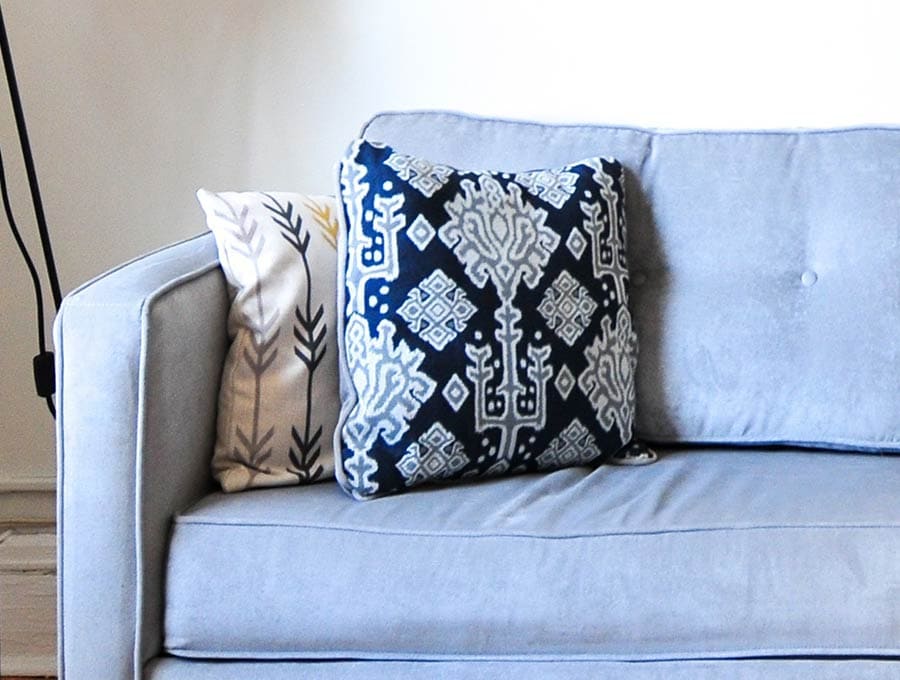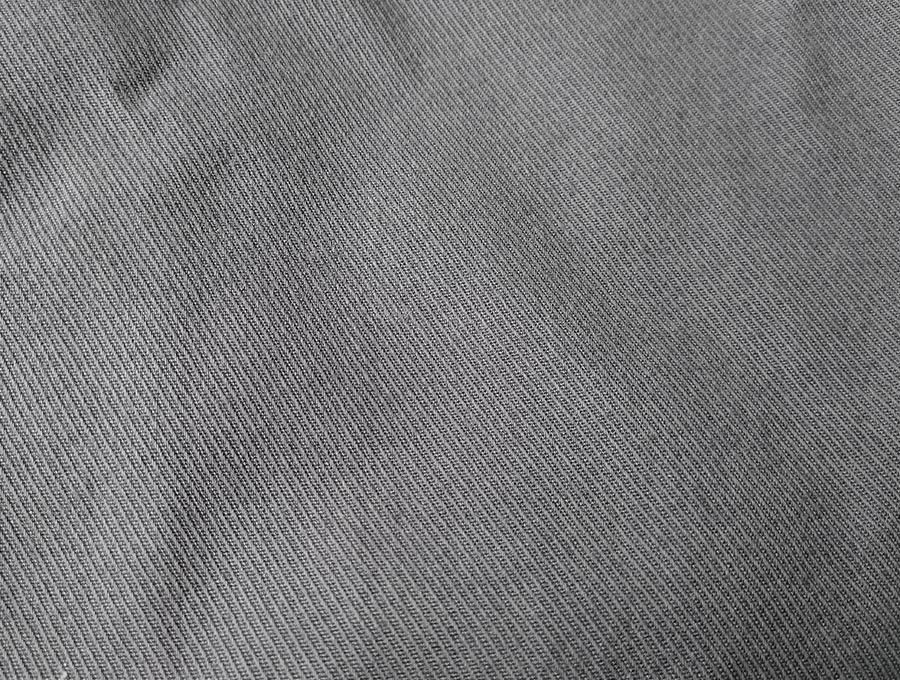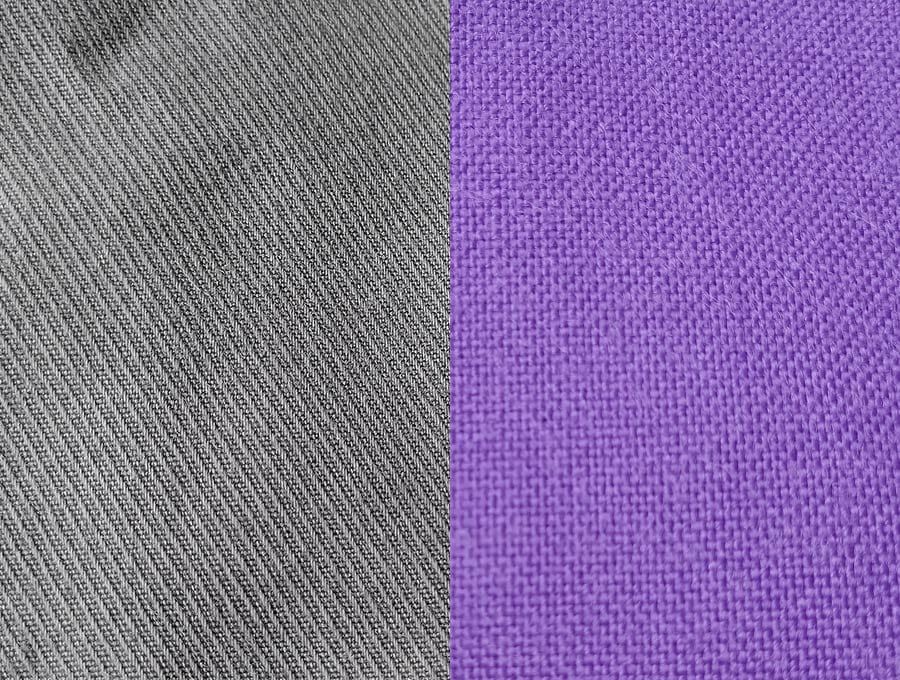What is Twill Fabric and How to Sew it
Twill is one of the three major types of textile weaves, along with satin and plain weaves. Twill fabric is a type of textile weave pattern that is easily recognizable by its diagonal pattern. It creates a durable and versatile fabric which makes it perfect for a wide range of clothing styles. Its diagonal pattern, created by weaving the threads over and under each other, gives it a unique look and feel. It is a durable and versatile fabric that can be made from a variety of fibers, including cotton, wool, and silk. Twill fabric is commonly used in clothing, upholstery, and accessories due to its strength and resistance to wrinkles. Whether you are looking for a lightweight, breathable fabric or a durable fabric that can withstand heavy use, twill fabric is a great choice.
Table of Contents
What Is Twill Fabric?

Twill fabric is a type of textile that is woven in a specific way to create a distinct diagonal pattern. This pattern is created by weaving the threads over and under each other in a way that creates a diagonal line. Twill fabric is made from a variety of materials, including cotton, polyester, wool, silk, and synthetic fibers.
Twill fabric is known for its durability and stretch, making it a popular choice for clothing that needs to be both comfortable and long-lasting. It is also breathable, making it a great choice for warm weather clothing. The versatility of twill fabric makes it a popular choice for a wide range of clothing, from casual wear to formal wear.
One of the key characteristics of twill fabric is its durability. The diagonal pattern of the weave creates a strong fabric that can withstand wear and tear. This makes it a great choice for clothing that will be worn frequently or for items that need to be able to withstand heavy use.
Another benefit of twill fabric is its lightweight composition. This makes it a great choice for clothing that needs to be comfortable and easy to wear. The fabric is also very versatile, making it a great choice for a wide range of clothing styles and designs.
How Is Twill Fabric Made?
The weaving process for twill fabric is different than other types of fabrics. The weft thread passes over two or more warp threads before going under one or more warp threads. This creates the diagonal pattern that is characteristic of twill fabric. The diagonal pattern is also known as the twill line.
Twill fabric can be made from a variety of fibers, including cotton, polyester, wool, and synthetic fibers. Cotton twill is a common choice for clothing, while polyester twill is often used for upholstery and home decor. Wool twill is a popular choice for suits and jackets.
There are different types of twill patterns, including cavalry twill, herringbone twill, and diamond twill. These patterns are created by varying the number of warp threads that the weft thread passes over and under.
Twill fabric can also have a technical face and technical back. The technical face is the side of the fabric that is visible when the fabric is used in a finished product. The technical back is the side of the fabric that is not visible in the finished product.
The quality of twill fabric is often determined by its thread count, which refers to the number of threads woven into each square inch of fabric. A higher thread count generally indicates a softer and more luxurious fabric. However, the type of fiber used in the fabric can also affect its quality and feel. Overall, twill fabric is a versatile and durable option for a variety of applications.
Overall, the weaving process for twill fabric is unique and creates a distinct diagonal pattern. Twill fabric can be made from a variety of fibers and can have different patterns and technical faces and backs.
How do you sew twill?
Sewing twill can be a bit tricky, but with the right techniques and tools, it can be done easily. Here are some tips to help you sew twill:
1. Choose the right needle and thread
When sewing twill, it’s important to use a heavy-duty needle, such as a denim or leather needle, as the fabric is thick and sturdy. A heavy-duty thread, such as polyester or nylon, is also recommended to ensure that the stitches are strong and durable.
2. Use the right stitch
A straight stitch or a triple stitch is recommended when sewing twill. A straight stitch is simple and easy to do, while a triple stitch is stronger and more durable.
3. Iron the fabric
Before sewing, it’s important to iron the twill fabric to remove any wrinkles or creases. Use a hot iron and press the fabric gently to avoid damaging it.
4. Pin the fabric
To prevent the fabric from shifting while sewing, it’s important to pin it in place. Use straight pins or clips to hold the fabric together.
5. Sew slowly and carefully
When sewing twill, it’s important to take your time and sew slowly and carefully. This will ensure that the stitches are straight and even.
6. Finish the edges
To prevent the edges of the twill fabric from fraying, it’s important to finish them. You can use a zigzag stitch or an overlock stitch to finish the edges.
7. Wash the fabric
After sewing, it’s important to wash the twill fabric to remove any dirt or stains. Use a gentle cycle and cold water to avoid damaging the fabric.
By following these tips, you can sew twill fabric easily and create beautiful and durable projects.
Sewing Projects for Twill Fabric
Twill fabric is a versatile material that can be used for a variety of sewing projects. From clothing to accessories, twill fabric can be used to create durable and stylish items. Here are a few sewing project ideas for twill fabric:
Clothing
Twill fabric is a popular choice for clothing due to its durability and comfort. Here are a few clothing items that can be made with twill fabric:
- Jackets: Twill fabric is a great choice for jackets due to its durability and ability to hold up well in cold weather. A twill jacket can be made in a variety of styles, from casual to formal.
- Pants: Twill fabric is often used for pants, especially chinos. Twill chinos are a classic style that can be dressed up or down depending on the occasion.
- Suits: Twill fabric can be used to make suits that are both durable and stylish. A twill suit is a great choice for a formal occasion.
Bags
Twill fabric is also a great choice for bags due to its durability and strength. Here are a few bag ideas:
- Tote bags: Twill fabric can be used to make sturdy tote bags that are perfect for carrying groceries or other items.
- Backpacks: Twill fabric is a great choice for backpacks due to its durability and ability to hold up well over time.
Accessories
Twill fabric can also be used to make a variety of accessories. Here are a few ideas:
- Headbands: Twill fabric can be used to make stylish and durable headbands that are perfect for holding back hair.
- Scrunchies: Twill fabric can be used to make scrunchies that are both stylish and functional.
- Bow ties: Twill fabric can be used to make bow ties that are perfect for formal occasions.
Twill fabric is a versatile material that can be used for a variety of sewing projects. Whether you’re making clothing, bags, or accessories, twill fabric is a great choice for its durability and strength.
Twill vs Denim
Denim is a type of heavyweight twill fabric. Denim is made out of cotton, while twill can be made using either cotton, polyester, wool, and synthetic fibers.
Twill Weave Vs Plain Weave
Twill weave and plain weave are two distinct weave patterns that produce different appearances and properties in fabrics. Twill weave has a diagonal rib pattern and a higher thread count, while plain weave has a balanced, checkerboard-like appearance and a lower thread count. The main difference between these two weaves is the way the threads are interlaced and the resulting appearance of the fabric.
Plain Weave
Plain weave, also known as tabby weave, is the simplest and most common weave pattern. In this weave, the weft thread passes over and under the warp thread in a regular, alternating pattern. This results in a fabric with a balanced, checkerboard-like appearance and a relatively low thread count.
Twill Weave
Twill weave, on the other hand, is characterized by a diagonal line or rib pattern that runs across the fabric. This is achieved by interlacing the weft thread over one or more warp threads before passing under one or more warp threads. The diagonal lines can be seen more clearly on the surface of the fabric, and the weave has a higher thread count than plain weave.
Twill weave is often used in heavier fabrics, such as denim, because it is stronger and more durable than plain weave. It is also used in fabrics that require a softer hand, such as silk, because the diagonal pattern creates a more flexible and drapey fabric.
What Are The Two Types Of Twill Weave
There are two types of twill weave: S-Twill and Z-Twill. These two types of twill weave are differentiated by the direction of the diagonal pattern they produce.
- S-Twill is a type of twill weave that produces a diagonal pattern that runs from the top left corner of the fabric to the bottom right corner. This type of twill weave is commonly used in the production of denim, chino, and other casual fabrics.
- Z-Twill, on the other hand, produces a diagonal pattern that runs from the top right corner of the fabric to the bottom left corner. This type of twill weave is commonly used in the production of dress pants, suits, and other formal fabrics.
Both S-Twill and Z-Twill are commonly used in the production of fabrics like gabardine, tweed, herringbone, and serge. The choice of twill weave used in the production of a fabric depends on the desired look and feel of the final product.
Twill FAQ
Is Twill Expensive?
Twill fabric can be found at a range of prices, depending on the material and manufacturer. Generally speaking, twill is not considered an expensive fabric. However, the price can vary depending on the quality of the fabric and the brand.
Is Twill Fabric Soft?
Twill fabric can be soft, but it depends on the material used to make it. Cotton twill fabric, for example, is often soft and comfortable to wear. However, twill made from synthetic materials may not be as soft.
Is Twill Easy to Wash?
Twill fabric is usually easy to wash and care for. It can be machine washed in cold water and tumble dried on low heat. However, it’s important to check the care instructions for the specific twill fabric you’re working with, as some may require special handling.
Maintaining Twill
To maintain the quality of twill fabric, it’s important to follow the care instructions provided by the manufacturer. This may include washing on a gentle cycle, avoiding bleach, and ironing on a low temperature.
Does Twill Wrinkle?
Twill fabric can wrinkle, but it is less prone to wrinkles than some other fabrics. If you’re concerned about wrinkles, consider choosing a twill blend that includes a wrinkle-resistant material.
Which Season Is Twill Fabric For?
Twill fabric is versatile and can be worn in any season. It’s often used for fall and winter clothing due to its durability and warmth, but it can also be used for lightweight summer clothing.
Is Twill Fabric Breathable?
Twill fabric can be breathable, but it depends on the material used to make it. Cotton twill, for example, is often breathable and comfortable to wear in warm weather. However, twill made from synthetic materials may not be as breathable.
Conclusion
Twill fabric is a versatile and durable textile that has been used in a variety of applications for centuries. Its unique weaving pattern gives it a distinctive look and feel that sets it apart from other fabrics. Twill fabric is a versatile and durable textile that can be used in a variety of applications. Its unique weaving pattern and distinctive drape make it a popular choice for clothing and upholstery, while its durability makes it ideal for heavy-duty applications. Whether you’re looking for a sustainable option or a high-performance fabric, twill is definitely worth considering.





